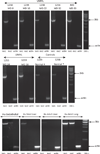SLC44A2 single nucleotide polymorphisms, isoforms, and expression: Association with severity of Meniere's disease?
- PMID: 27829169
- PMCID: PMC5258118
- DOI: 10.1016/j.ygeno.2016.11.002
SLC44A2 single nucleotide polymorphisms, isoforms, and expression: Association with severity of Meniere's disease?
Abstract
SLC44A2 was discovered as the target of an antibody that causes hearing loss. Knockout mice develop age related hearing loss, loss of sensory cells and spiral ganglion neurons. SLC44A2 has polymorphic sites implicated in human disease. Transfusion related acute lung injury (TRALI) is linked to rs2288904 and genome wide association studies link rs2288904 and rs9797861 to venous thromboembolism (VTE), coronary artery disease and stroke. Here we report linkage disequilibrium of rs2288904 with rs3087969 and the association of these SLC44A2 SNPs with Meniere's disease severity. Tissue-specific isoform expression differences suggest that the N-terminal domain is linked to different functions in different cell types. Heterozygosity at rs2288904 CGA/CAA and rs3087969 GAT/GAC showed a trend for association with intractable Meniere's disease compared to less severe disease and to controls. The association of SLC44A2 SNPs with VTE suggests that thrombi affecting cochlear vessels could be a factor in Meniere's disease.
Keywords: Amino acid polymorphisms; Choline transporter-like protein 2: solute carrier protein 44A2; DNA sequence differences; Hearing; Human gene expression; Meniere's disease; Vestibular tissue.
Copyright © 2016 Elsevier Inc. All rights reserved.
Figures




References
-
- Zajic G, Nair TS, Ptok M, et al. Monoclonal antibodies to inner ear antigens: I. Antigens expressed by supporting cells of the guinea pig cochlea. Hear Res. 1991;52:59–71. - PubMed
-
- Ptok M, Nair TS, Altschuler RA, Schacht J, Carey TE. Monoclonal antibodies to inner ear antigens: II. Antigens expressed in sensory cell stereocilia. Hear Res. 1991;57:79–90. - PubMed
-
- Ptok M, Nair T, Carey TE, Altschuler RA. Distribution of KHRI 3 epitopes in the inner ear. Hear Res. 1993;66:245–252. - PubMed
-
- Nair TS, Prieskorn DM, Miller JM, Dolan DF, Raphael Y, Carey TE. KHRI-3 monoclonal antibody-induced damage to the inner ear: antibody staining of nascent scars. Hear Res. 1999;129:50–60. - PubMed
-
- Nair TS, Prieskorn DM, Miller JM, Mori A, Gray J, Carey TE. In vivo binding and hearing loss after intracochlear infusion of KHRI-3 antibody. Hear Res. 1997;107:93–101. - PubMed
Publication types
MeSH terms
Substances
Grants and funding
LinkOut - more resources
Full Text Sources
Other Literature Sources
Medical
Research Materials

